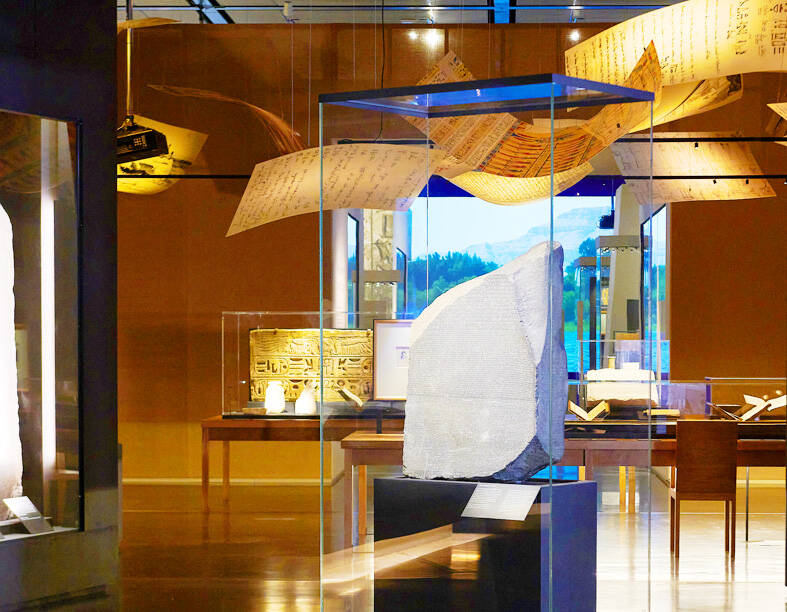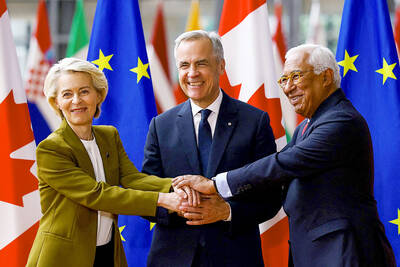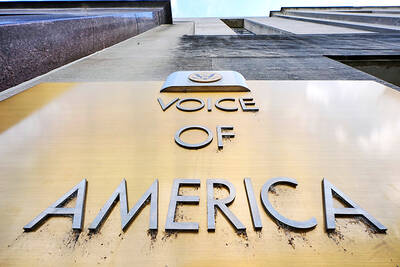The debate over who owns ancient artifacts has been an increasing challenge to museums across Europe and the US, and the spotlight has fallen on the most visited piece in the British Museum: The Rosetta Stone.
The inscriptions on the black granite slab became the seminal breakthrough in deciphering ancient Egyptian hieroglyphics after it was taken from Egypt by forces of the British empire in 1801.
Now, as Britain’s largest museum marks the 200-year anniversary of the decipherment of hieroglyphics, thousands of Egyptians are demanding the stone’s return.

Photo: AP
“The British Museum’s holding of the stone is a symbol of Western cultural violence against Egypt,” said Egyptologist Monica Hanna, who is dean at the Arab Academy for Science, Technology & Maritime Transport and organizer of one of two petitions calling for the stone’s return.
The acquisition of the Rosetta Stone was tied up in the imperial battles between Britain and France. After Napoleon Bonaparte’s military occupation of Egypt, French scientists uncovered the stone in 1799 in the northern town of Rashid, known by the French as Rosetta.
When British forces defeated the French in Egypt, the stone and more than a dozen other antiquities were handed over to the British under the terms of an 1801 surrender deal between the generals of the two sides.
It has remained in the British Museum since.
Hanna’s petition, with 4,200 signatures, says the stone was seized illegally and constitutes a “spoil of war.” The claim is echoed in a near identical petition by former Egyptian minister of antiquities Zahi Hawass, which has more than 100,000 signatures.
Hawass said that Egypt had no say in the 1801 agreement.
The British Museum denies this.
In a statement, the Museum said the 1801 treaty includes the signature of a representative of Egypt. It refers to an Ottoman admiral who fought alongside the British against the French. The Ottoman sultan in Istanbul was nominally the ruler of Egypt at the time of Napoleon’s invasion.
The Museum also said that Egypt’s government has not submitted a request for its return, adding that there are 28 known copies of the same engraved decree and 21 of them remain in Egypt.
The contention over the original stone copy stems from its unrivaled significance to Egyptology. Carved in the second century BC, the slab contains three translations of a decree relating to a settlement between the then-ruling Ptolemies and a sect of Egyptian priests.
The first inscription is in classic hieroglyphics, the next is in a simplified hieroglyphic script known as Demotic, and the third is in Ancient Greek.
Through knowledge of the latter, academics were able to decipher the hieroglyphic symbols, with French Egyptologist Jean-Francois Champollion eventually cracking the language in 1822.
“Scholars from the previous 18th century had been longing to find a bilingual text written in a known language,” said Ilona Regulski, the head of Egyptian Written Culture at the British Museum.
Regulski is the lead curator of the museum’s winter exhibition, “Hieroglyphs Unlocking Ancient Egypt,” celebrating the 200th anniversary of Champollion’s breakthrough.
The stone is one of more than 100,000 Egyptian and Sudanese relics housed in the British Museum. A large percentage were obtained during Britain’s colonial rule over the region from 1883 to 1953.
It has grown increasingly common for museums and collectors to return artifacts to their country of origin, with new instances reported nearly monthly. Often, it is the result of a court ruling, while some cases are voluntary, symbolizing an act of atonement for historical wrongs.
New York’s Metropolitan Museum of Art returned 16 antiquities to Egypt in September after a US investigation concluded they had been illegally trafficked. On Monday, London’s Horniman Museum and Gardens signed over 72 objects, including 12 Benin Bronzes, to Nigeria following a request from its government.
Nicholas Donnell, a Boston-based attorney specializing in cases concerning art and artifacts, said that no common international legal framework exists for such disputes.
Unless there is clear evidence an artifact was acquired illegally, repatriation is largely at the discretion of the museum.
“Given the treaty and the timeframe, the Rosetta Stone is a hard legal battle to win,” Donnell said.
Nigel Hetherington, an archeologist and CEO of the online academic forum Past Preservers, said that the museum has a motive.
“It’s about money, maintaining relevance and a fear that in returning certain items people will stop coming,” he said.

Drug lord Jose Adolfo Macias Villamar, alias “Fito,” was Ecuador’s most-wanted fugitive before his arrest on Wednesday, more than a year after he escaped prison from where he commanded the country’s leading criminal gang. The former taxi driver turned crime boss became the prime target of law enforcement early last year after escaping from a prison in the southwestern port of Guayaquil. Ecuadoran President Daniel Noboa’s government released “wanted” posters with images of his face and offered US$1 million for information leading to his capture. In a country plagued by crime, members of Fito’s gang, Los Choneros, have responded with violence, using car

Canada and the EU on Monday signed a defense and security pact as the transatlantic partners seek to better confront Russia, with worries over Washington’s reliability under US President Donald Trump. The deal was announced after a summit in Brussels between Canadian Prime Minister Mark Carney and European Commission President Ursula von der Leyen and European Council President Antonio Costa. “While NATO remains the cornerstone of our collective defense, this partnership will allow us to strengthen our preparedness ... to invest more and to invest smarter,” Costa told a news conference. “It opens new opportunities for companies on both sides of the

The team behind the long-awaited Vera Rubin Observatory in Chile yesterday published their first images, revealing breathtaking views of star-forming regions as well as distant galaxies. More than two decades in the making, the giant US-funded telescope sits perched at the summit of Cerro Pachon in central Chile, where dark skies and dry air provide ideal conditions for observing the cosmos. One of the debut images is a composite of 678 exposures taken over just seven hours, capturing the Trifid Nebula and the Lagoon Nebula — both several thousand light-years from Earth — glowing in vivid pinks against orange-red backdrops. The new image

OVERHAUL: The move would likely mark the end to Voice of America, which was founded in 1942 to counter Nazi propaganda and operated in nearly 50 languages The parent agency of Voice of America (VOA) on Friday said it had issued termination notices to more than 639 more staff, completing an 85 percent decrease in personnel since March and effectively spelling the end of a broadcasting network founded to counter Nazi propaganda. US Agency for Global Media (USAGM) senior advisor Kari Lake said the staff reduction meant 1,400 positions had been eliminated as part of US President Donald Trump’s agenda to cut staffing at the agency to a statutory minimum. “Reduction in Force Termination Notices were sent to 639 employees at USAGM and Voice of America, part of a